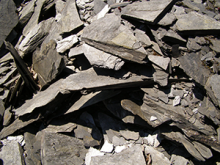Article
Slate occurs when tectonic plates collide, creating heat and pressure that metamorphize the elements of which the plates are composed. Slate is the metmorphic form of shale, and occurs rather early in the metamorphic process. Slate that continues to be subjected to tectonic pressure results in phyllite, a higher, or denser and finer, grade of rock. In the U.S. Southwest, the occurrence of slate is relatively rare, as many rock formations are the result of geologic processes further along the metamorphic scale from the slightly early production of slate, resulting in a range if schist, gneiss, and ultimately granite, the primary component of much the Southwest's mountainous terrain.
Slate's lower grade makes it easy to use, because it fractures, or cleaves, easily into long, flat plates. Slate is also an attractive stone that can be found in muted colors of blue, black, green, gray and purple.
"Slate" by Erich Ferdinand is licensed under CC BY.
Manuscripts
References
Dale, T. Nelson
1914 Slate in the United States. Washington: Government Printing Office.
Minerals Education Coalition
N.d. Slate. https://www.mineralseducationcoalition.org/minerals/slate, accessed July 7,
2016.

